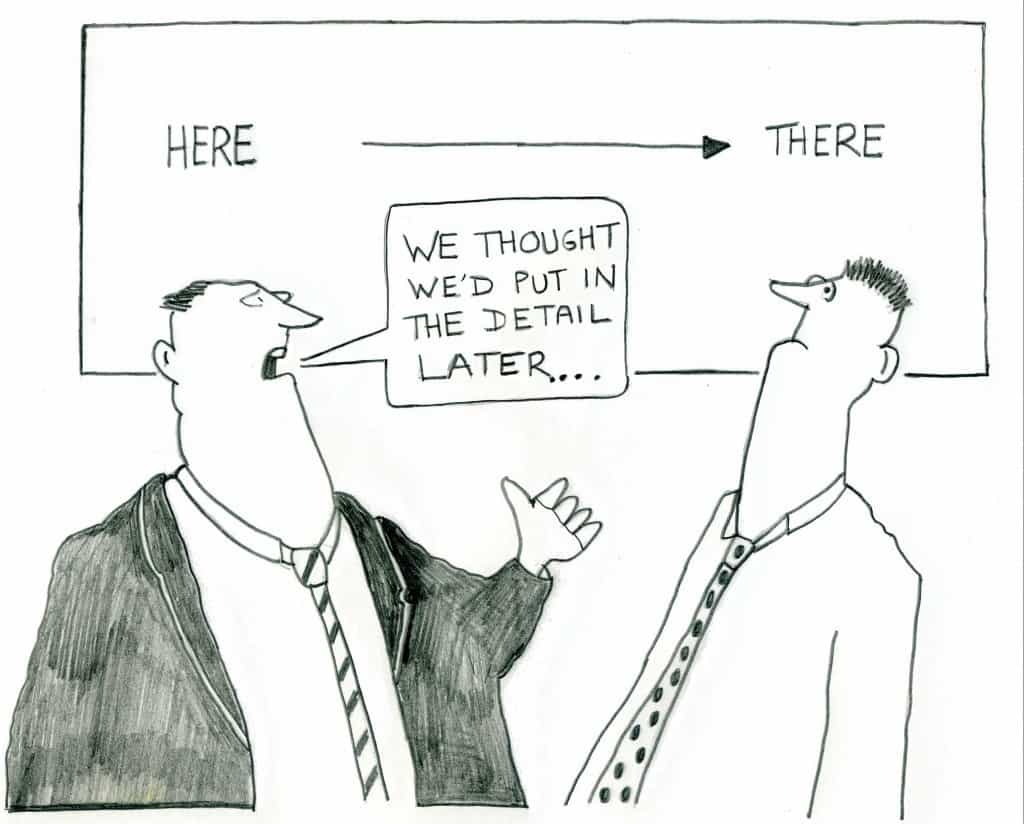Does Your Sales and Marketing Business Planning Process look like this?
While business planning is generally important for small and medium-sized enterprises (SMEs) to establish their goals, strategies, and resources needed to achieve success, there may be certain scenarios where it is not strictly required. Some examples where sales and marketing business planning not required:
- Small businesses that operate in stable or predictable industries may not require a detailed business plan. For example, a small machine shop that has been in operation for many years and has a steady customer base may not need to create a formal business plan.
- Businesses that are focused on short-term goals or opportunities may not require a formal business plan. For example, a small online retailer that is selling a limited number of products for a short time may not need a comprehensive business plan.
- Businesses that are self-funded or have minimal external investment may not require a formal business plan. For example, a small service business that operates from home and has minimal expenses may not need a detailed business plan.
Some level of Sales & Marketing Planning Required
However, it’s important to note that even in these situations, some level of planning and strategy is still required for a successful operation. At a minimum, a business owner should have a clear understanding of their market, competition, target audience, and the resources needed to achieve their goals. A simplified or informal business plan may be sufficient for some small businesses, but having some level of planning can help SMEs navigate challenges, take advantage of opportunities, and achieve their desired outcomes.
If your sales and marketing business planning process follows the one shown on the right then is that a problem?
Planning might not be necessary for your business
When you can put forward a very good case that your business can operate effectively without improved planning.
- If your company is already highly profitable and achieving the growth that you require
- You are operating in both an efficient and effective manner
- Has a clear insight as to how the business will be performing within its existing and new markets over the next few years
Planning might not be necessary if you already have a highly effective sales process
If you have an excellent sales conversion ratio from proposals submitted to business won. Plus if you have already have a constant stream of interested prospects beating a path to your door for you to quote on providing your product or service then potentially there is no need for you to change your approach.
Planning might not be necessary if your marketing ROI is high
Now if you are the type of company that measures the performance of all its sales and marketing activities in order to maximise the ROI.
If you know exactly what you are going to do from a sales and marketing perspective and are already setting specific activities, clear budgets and identifying expected outcomes. Then your current approach seems fine.
Are You Confident Your Marketing and Sales is at an Optimum Performance Level
Are you 100% confident that the money and time you are spending on sales and marketing activities is working as effectively as it could.
A sales and marketing business planning process should typically include the following components:
- Market research and analysis: Conduct research and analysis on the market, including customer needs and preferences, industry trends, competition, and potential opportunities and challenges.
- Define target customers: Define the specific target customer segments that the business will focus on and understand their needs, behaviours, and preferences.
- Set goals and objectives: Define measurable sales and marketing goals and objectives that align with the overall business strategy and vision.
- Develop a marketing strategy: Develop a marketing strategy that outlines the channels, tactics, and messaging that will be used to reach and engage the target customers.
- Define the sales process: Define the sales process, including the steps involved, the roles and responsibilities of the sales team, and any supporting tools or resources required.
- Set performance metrics: Define the key performance indicators (KPIs) that will be used to measure the effectiveness of the sales and marketing efforts and track progress towards the defined goals and objectives.
- Allocate resources: Allocate resources such as budget, personnel, and technology to support the execution of the sales and marketing plan.
- Implementation and monitoring: Implement the sales and marketing plan and regularly monitor progress and adjust the plan as needed to achieve the desired results.
- Review and evaluate: Conduct regular reviews and evaluations of the sales and marketing plan to identify areas for improvement and make adjustments to the strategy and tactics as needed.
By following a comprehensive sales and marketing planning process, businesses can ensure that their sales and marketing efforts are targeted, measurable, and aligned with their overall business strategy and goals.
The benefits of proper planning to tactical activities
| Marketing / Promotional Activity | Typical issues when planning poor | Improvements Achieved When Specialist Planning Initiated |
| Advertising in printed publications (trade magazines / directories / newspapers) | Money wasted, no ability to measure or track, lost sales opportunities | Adverts placed in the correct publications, with correct messages generate more enquiries |
| Trade exhibitions | Money wasted, fewer and lower quality leads | Increased exposure for the same money, more leads and improved follow up |
| Brochures, folders, leaflets and even business cards | You end up with “Pretty” documents that actually serve little purpose in gaining customers | Printed materials suddenly gain a purpose and generate greater interest |
| Your website | Missed opportunities for lead acquisition and customer interaction | Attracts higher volumes of interested enquiries and demonstrates increased credibility |
| Any online advertising – Google ad words or Facebook advertising | Wasted money – Its called Google Tax for a reason – i.e. its there to penalise those who do it badly | 40% budget savings typically ppossible with significant increases in click throughs |
| Discounts or special offers | Lost profit | No more wasted promotions that lose you money |
| E mail marketing | Missed opportunities, poor opening rates | When implemented correctly high open rates (50%) and great engagement |
The Importance Of Intelligent Customer Segmentation
Intelligent customer segmentation is a crucial aspect of modern marketing and sales strategies. Customer segmentation is the process of dividing customers into groups based on shared characteristics, such as demographics, behaviour, or preferences. Intelligent customer segmentation refers to the use of data analytics and machine learning algorithms to identify patterns and make informed decisions about how to group customers.
Here are some reasons why intelligent customer segmentation is so important:
- Personalisation: By grouping customers based on shared characteristics, businesses can tailor their marketing and sales efforts to be more relevant and effective. This can lead to higher conversion rates, increased customer satisfaction, and stronger brand loyalty.
- Efficient Resource Allocation: By segmenting customers, businesses can optimise their marketing and sales resources, such as advertising budgets and sales staff. They can focus on the segments that are most likely to convert, and avoid wasting resources on segments that are unlikely to buy.
- Improved Customer Retention: By understanding the needs and preferences of each customer segment, businesses can develop targeted retention strategies that help to keep customers engaged and satisfied.
- Better Insights: Intelligent customer segmentation allows businesses to gain a deeper understanding of their customer base. By analysing customer behaviour and preferences, businesses can identify trends and patterns that can inform product development, marketing strategies, and other business decisions.
- Competitive Advantage: By leveraging intelligent customer segmentation, businesses can gain a competitive advantage by providing a more personalised, targeted customer experience. This can lead to increased market share and revenue growth.
In today’s data-driven business environment, intelligent customer segmentation is essential for effective marketing and sales strategies. By leveraging the power of data analytics and machine learning, businesses can gain a deeper understanding of their customers and make informed decisions about how to engage with them.
Intelligent Segmentation Based Around Buying Behaviour (It’s about getting personal)
This example illustrates the need for intelligent segmentation.
Do you think that both these consumers would have similar buying behaviours?
From The Statistics They Look Similar
- Same age
- English
- Married
- Have children
- Have money
- Similar holiday requirements
- Pet lovers
So potentially person 1 and person 2 are very similar people.

- Born in 1948 and grew up in England
- Twice Married
- 2 children
- Successful in business
- Wealthy
- Spends winter holidays in the Alps
- Likes dogs


- Born in 1948 and grew up in England
- Twice Married
- 2 children
- Successful in business
- Wealthy
- Spends winter holidays in the Alps
- Likes dogs

Selling Mistakes – Do You Make Any Of These
Selling Mistakes Impact On Conversion, Profit & Credibility
Selling varies significantly from at its simplest simply taking the cash for the transaction through to complex negotiations and bid writing. In this article we consider more complex selling scenarios and look at 4 classic mistakes that occur when selling.
Selling Mistake 1: Quoting To Early
One of the key attributes to selling is actively listening to the customer. A problem occurs when you offer a solution that that you want to sell as opposed to the customer actually requesting. This is then amplified when you provide a quote or supply a proposal too early in the selling process.
Selling Mistake 2: Offering Discounts
This can be split into a number of sub mistakes
- Offering discounts as a mechanism to stimulate a sale when no reduction in price is required
- Having discounts that are completely fictitious as an approach to being able to offer a great deal i.e.
- Get this package of online training and dvd’s and audio files and books and etc Normally £999
- Only 100 packs available Reduced to £499
- As we want to really make you think you are getting a bargain For one day only £49
- Only 100 packs available Reduced to £499
- Get this package of online training and dvd’s and audio files and books and etc Normally £999
- Not actually realising the implications of the profit you are losing and additional sales that will be required .
Selling Mistake 3: Charging For Time
If you are a trades person or consultant and are selling your time then you have automatically limited your earning potential. For example if you were a skilled CNC machinist and are charging £50 per hour. Then the maximum you can earn for a 40 hour week is £2000 per week. Now if you were pricing on a project basis there could be the potential for generating significantly more revenue. There is a need to uncouple price from cost and effort
Selling Mistake 4: Invoicing To Late
Picture this scenario
- A customer asks you to complete some work on the first day of the month.
- You complete the work over the next couple of days
- You wait until the end of the month and invoice
- Your payment terms are 30 days
- Your customer pays promptly on the thirtieth day
- Essentially you have delivered a service but waited almost 60 days for payment
Sales & Marketing Business Summary
In an SME (Small and Medium-sized Enterprise) business, marketing and sales activities play crucial roles in driving business growth and generating revenue. While marketing focuses on creating awareness, building brand reputation, and attracting potential customers, sales teams are responsible for converting those leads into paying customers. To ensure their success, it is important for marketing and sales to work together closely and collaborate effectively:
- Alignment of goals: Marketing and sales should have a shared understanding of the company’s overall objectives. They need to align their goals and strategies to ensure they are working towards the same end result.
- Communication and feedback: Regular and open communication channels between marketing and sales are essential. Sales teams can provide valuable insights about customer preferences, pain points, and objections, which can help marketers refine their strategies. In turn, marketing teams can share information on campaigns, target audiences, and new leads with the sales department.
- Lead generation and nurturing: Marketing plays a key role in generating leads through various channels such as advertising, content marketing, social media, and SEO. Sales teams can provide input on the type of leads they find most valuable, enabling marketing to refine their lead generation efforts accordingly. Marketing can also support sales by nurturing leads through email campaigns, personalized content, and marketing automation, helping to warm them up before handing them off to the sales team.
- Collaborative content creation: Marketing can create relevant and engaging content that supports the sales process. This includes sales collateral such as brochures, case studies, white papers, and product demonstrations. Sales teams can provide input on the specific needs and challenges they encounter while interacting with customers, which marketing can incorporate into their content strategy.
- Customer journey alignment: Marketing and sales need to ensure that the customer journey is seamless from initial contact to final purchase. They should work together to map out the customer journey, identify touchpoints, and optimise the experience at each stage. This collaboration ensures a consistent message and smooth transition for customers as they move from marketing interactions to sales conversations.
- Analytics and data sharing: Both marketing and sales teams should share data and insights to measure the effectiveness of their efforts and identify areas for improvement. By analyzing data on lead conversion rates, customer behaviour, and campaign performance, they can identify successful strategies and adjust their tactics accordingly.
- Continuous improvement and feedback loop: Marketing and sales should regularly review their performance, share feedback, and make necessary adjustments. This collaborative approach allows for continuous improvement and helps refine marketing strategies and sales techniques over time.
By fostering collaboration and a strong working relationship, marketing and sales teams in an SME business can leverage each other’s strengths and maximise their impact on business growth and revenue generation.







